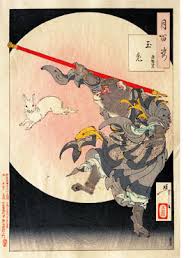 In the following pages provides a brief online tour of the Japanese art collection of LACMA. This tour includes sculptures, paintings, prints and ceramics. For more information on Japanese art, please visit our collection in person or call the Department of Japanese Art at (323) 857-6565. Also visit our Collections Online.
In the following pages provides a brief online tour of the Japanese art collection of LACMA. This tour includes sculptures, paintings, prints and ceramics. For more information on Japanese art, please visit our collection in person or call the Department of Japanese Art at (323) 857-6565. Also visit our Collections Online.The Pavilion
The Pavilion for Japanese art is unique in America as a separate building dedicated to the exhibition of Japanese art in a large museum complex encyclopedic. The Pavilion houses the museum's collection of Japanese works dating from around 3000 BC to the twentieth century. The second level, west wing gallery is devoted to the exhibition of archaeological materials, Buddhist and Shinto sculpture, ceramics rendered in a calm and naturalistic style of tea or prepared for decoration or food service, lacquer work, textiles, armor and cloisonne. Some objects in this gallery are rotated occasionally, textiles are rotated quarterly. The adjacent space, the Helen and Felix Juda Gallery, is reserved mainly for rotating exhibitions of Japanese prints. Collection of Japanese prints from the museum contains important examples of traditional woodblock prints from the Edo period (1615-1868), especially in the late eighteenth and nineteenth century. The strength of the print collection, however, lies in the more than fifteen hundred copies of the Meiji era (1868-1912), Taisho (1912-1926) and Showa (1926-1989) periods. Sample on the basis of periods, themes or styles change every three months.
The heart of exhibition space built the pavilion is only the east wing, where the paintings are displayed for six weeks to three months. Edo-period works ranging from finely painted work of Rimpa, ukiyo-e, and Maruyama-Shijo school to spontaneous expressions of Zen monks-form the core of the collection of Japanese paintings from the museum. The paintings are naturally lit by sunlight filtered through streaming fiberglass panels. The effect is close to the original viewing conditions of these paintings and allows gold leaf, to reflect, create dimensional levels within the artwork is not visible when illuminated artificially. The displays can be seen from a distance, and the rolls are more in settings suggesting alcovelike tokonoma display area, in a Japanese house. Paintings are displayed in six levels in the east wing.
The Raymond and Frances Bushell Netsuke Gallery on the plaza level of the museum offers visitors the unique opportunity to see from all sides of the miniature sculptures known as netsuke. Netsuke were used as a lever and counterweight to help hang bags or boxes suspended from the belt of a man's kimono. The collection contains an array of 836 Bushell encyclopedic works of the seventeenth to the twentieth century. Netsuke facilities consist of 150 works grouped by topic and are rotated every three months. Inro, lacquer boxes used to transport drugs or used as purely decorative clothing, are also shown in the gallery Bushell.
Note: Macrons and other diacritical marks can be problematic for some browsers. We skipped over these pages.
Tags: Art, Painting
0 comments:
Post a Comment